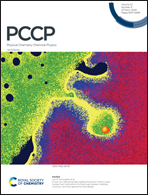The valence and Rydberg states of dienes†
Abstract
The molecules 1,4-cyclohexadiene (unconjugated 1,4-CHD) and 1,3-cyclohexadiene (conjugated 1,3-CHD) both have two double bonds, but these bonds interact in different ways. These molecules have long served as examples of through-bond and through-space interactions, respectively, and their electronic structures have been studied in detail both experimentally and theoretically, with the experimental assignments being especially complete. The existence of Rydberg states interspersed with the valence states makes the quantum mechanical calculation of their spectra a challenging task. In this work, we explore the electronic excitation energies of 1,4-CHD and 1,3-CHD for both valence and Rydberg states by means of complete active space second-order perturbation theory (CASPT2), extended multi-state CASPT2 (XMS-CASPT2), and multiconfiguration pair-density functional theory (MC-PDFT); it is shown by comparison to experiment that MC-PDFT yields the most accurate results. We found that the inclusion of Rydberg orbitals in the active space not only enables the calculation of Rydberg excitation energies but also improves the accuracy of the valence ones. A special characteristic of the present analysis is the calculation of the second moments of the excited-state orbitals. Because we find that the CASPT2 densities agree well with the CASSCF ones and since the MC-PDFT methods gets accurate excitation energies based on the CASSCF densities, we believe that we can trust these moments as far as giving a more accurate picture of the diffuseness of the excited-state orbitals in these prototype molecules than has previously been available.



 Please wait while we load your content...
Please wait while we load your content...